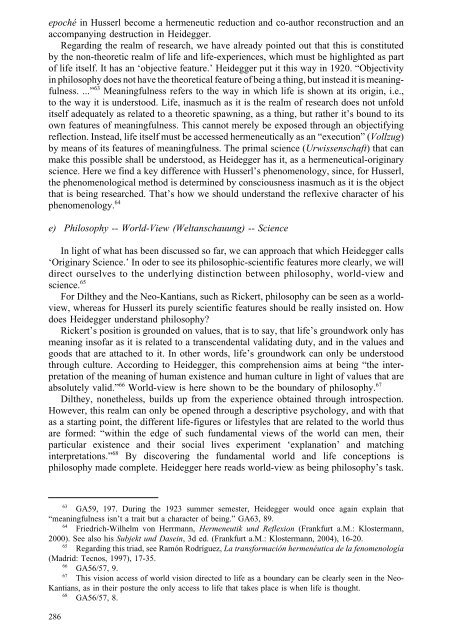[Andrzej_Wiercinski_(ed ... - WordPress.com
[Andrzej_Wiercinski_(ed ... - WordPress.com
[Andrzej_Wiercinski_(ed ... - WordPress.com
Create successful ePaper yourself
Turn your PDF publications into a flip-book with our unique Google optimized e-Paper software.
epoché in Husserl be<strong>com</strong>e a hermeneutic r<strong>ed</strong>uction and co-author reconstruction and anac<strong>com</strong>panying destruction in Heidegger.Regarding the realm of research, we have already point<strong>ed</strong> out that this is constitut<strong>ed</strong>by the non-theoretic realm of life and life-experiences, which must be highlight<strong>ed</strong> as partof life itself. It has an ‘objective feature.’ Heidegger put it this way in 1920. “Objectivityin philosophy does not have the theoretical feature of being a thing, but instead it is meaningfulness....” 63 Meaningfulness refers to the way in which life is shown at its origin, i.e.,to the way it is understood. Life, inasmuch as it is the realm of research does not unfolditself adequately as relat<strong>ed</strong> to a theoretic spawning, as a thing, but rather it’s bound to itsown features of meaningfulness. This cannot merely be expos<strong>ed</strong> through an objectifyingreflection. Instead, life itself must be access<strong>ed</strong> hermeneutically as an “execution” (Vollzug)by means of its features of meaningfulness. The primal science (Urwissenschaft) that canmake this possible shall be understood, as Heidegger has it, as a hermeneutical-originaryscience. Here we find a key difference with Husserl’s phenomenology, since, for Husserl,the phenomenological method is determin<strong>ed</strong> by consciousness inasmuch as it is the objectthat is being research<strong>ed</strong>. That’s how we should understand the reflexive character of hisphenomenology. 64e) Philosophy -- World-View (Weltanschauung) -- ScienceIn light of what has been discuss<strong>ed</strong> so far, we can approach that which Heidegger calls‘Originary Science.’ In oder to see its philosophic-scientific features more clearly, we willdirect ourselves to the underlying distinction between philosophy, world-view andscience. 65For Dilthey and the Neo-Kantians, such as Rickert, philosophy can be seen as a worldview,whereas for Husserl its purely scientific features should be really insist<strong>ed</strong> on. Howdoes Heidegger understand philosophy?Rickert’s position is ground<strong>ed</strong> on values, that is to say, that life’s groundwork only hasmeaning insofar as it is relat<strong>ed</strong> to a transcendental validating duty, and in the values andgoods that are attach<strong>ed</strong> to it. In other words, life’s groundwork can only be understoodthrough culture. According to Heidegger, this <strong>com</strong>prehension aims at being “the interpretationof the meaning of human existence and human culture in light of values that areabsolutely valid.” 66 World-view is here shown to be the boundary of philosophy. 67Dilthey, nonetheless, builds up from the experience obtain<strong>ed</strong> through introspection.However, this realm can only be open<strong>ed</strong> through a descriptive psychology, and with thatas a starting point, the different life-figures or lifestyles that are relat<strong>ed</strong> to the world thusare form<strong>ed</strong>: “within the <strong>ed</strong>ge of such fundamental views of the world can men, theirparticular existence and their social lives experiment ‘explanation’ and matchinginterpretations.” 68 By discovering the fundamental world and life conceptions isphilosophy made <strong>com</strong>plete. Heidegger here reads world-view as being philosophy’s task.63GA59, 197. During the 1923 summer semester, Heidegger would once again explain that“meaningfulness isn’t a trait but a character of being.” GA63, 89.64Fri<strong>ed</strong>rich-Wilhelm von Herrmann, Hermeneutik und Reflexion (Frankfurt a.M.: Klostermann,2000). See also his Subjekt und Dasein, 3d <strong>ed</strong>. (Frankfurt a.M.: Klostermann, 2004), 16-20.65Regarding this triad, see Ramón Rodríguez, La transformación hermenéutica de la fenomenología(Madrid: Tecnos, 1997), 17-35.66GA56/57, 9.67This vision access of world vision direct<strong>ed</strong> to life as a boundary can be clearly seen in the Neo-Kantians, as in their posture the only access to life that takes place is when life is thought.68GA56/57, 8.286


